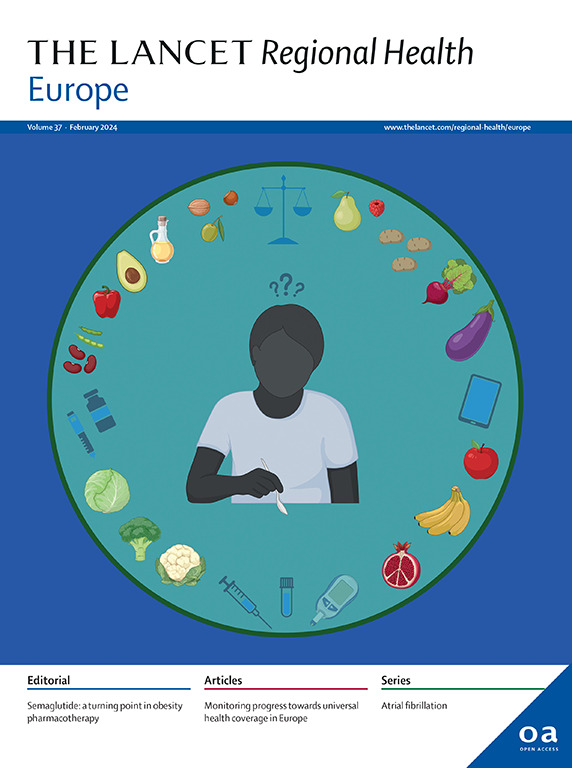食管切除术后鼻胃管与吻合口漏的风险:北欧,多中心,开放标签,随机,对照,非劣效性试验
IF 13
Q1 HEALTH CARE SCIENCES & SERVICES
引用次数: 0
摘要
食管切除术是食管癌根治性治疗的基石,是一项复杂的手术,并发症发生率高。术后胃管减压是有争议的,一些中心正在放弃常规鼻胃管的使用。我们假设,在吻合口漏的风险方面,术后拔除NG管不低于5天的NG管减压。方法在瑞典、挪威、丹麦和芬兰的12家医院进行的这项开放标签、非效性随机对照试验中,接受食管癌或胃食管结癌切除术的患者被随机分配(1:1)至术后无NG管组或5天NG管减压组。吻合口漏是主要结局,次要结局包括肺炎和住院时间。对治疗意向和每个方案人群进行分析,将吻合口瘘的非劣效性定义为风险差异低于9%。ISRCTN.com注册ISRCTN39935085。在2022年1月1日至2024年3月27日期间,448名患者被随机分配,217名患者术后未接受NG管治疗,231名患者接受5天NG管治疗。平均年龄67.5岁(标准差9.8),男性367岁(81.9%)。48例(22.1%(95%可信区间(CI) 16.8%, 28.2%)吻合口漏与35例(15.2%(95%可信区间(CI) 10.8%, 20.4%)吻合口漏相比,未行减压5天吻合口漏的风险差异为- 7.0% (95% CI - 14.4%, 0.00%),非劣效性差异为0.30。在一项补充分析中,如果术后使用NG减压,患者吻合口漏的风险较低。其他并发症(如肺炎)的发生率在两组之间相似。在每个方案分析中,NG管的风险差异为- 11.3% (95% CI, - 19.1, - 0.3%)。我们不能确定安全性(增加吻合口漏的风险),因此不支持食管切除术后省略NG管。这项试验由瑞典癌症协会和北欧癌症联盟资助。本文章由计算机程序翻译,如有差异,请以英文原文为准。
Nasogastric tube after oesophagectomy and risk of anastomotic leak: a Nordic, multicentre, open-label, randomised, controlled, non-inferiority trial
Background
Oesophagectomy, a corner stone in curative treatment of oesophageal cancer, is a complex procedure with high complication rates. Postoperative gastric tube decompression is debated and some centres are abandoning routine nasogastric (NG) tube use. We hypothesised that postoperative NG tube removal is non-inferior to five days of NG tube decompression, with regard to the risk of anastomotic leak.
Methods
In this open-label, non-inferiority randomised controlled trial across 12 hospitals in Sweden, Norway, Denmark and Finland, participants treated for oesophageal or gastroesophageal junctional cancer with oesophagectomy were randomly assigned (1:1) to no postoperative NG tube or five days of NG tube decompression. Anastomotic leak was the primary outcome and secondary outcomes included pneumonia and length of hospital stay. Analyses were performed on the intention to treat and per protocol populations and non-inferiority for anastomotic leak was defined as a risk difference below 9%. ISRCTN.com registration ISRCTN39935085.
Findings
Between January 1st 2022 and March 27th 2024, 448 patients were randomly assigned, 217 to no postoperative NG tube and 231 to five days NG tube treatment. The mean age was 67.5 (standard deviation (SD) 9.8) years and 367 (81.9%) were males. Non-inferiority with regard to anastomotic leak for no NG tube decompression could not be shown with 48 patients (22.1% (95% confidence interval (CI) 16.8%, 28.2%)) having anastomotic leak compared to 35 (15.2% (95% CI 10.8%, 20.4%)) with five days of NG tube decompression, a risk difference of −7.0% (95% CI −14.4%, 0.00%), pnon-inferiority 0.30. In a Supplementary analysis, patients had a lower risk of anastomotic leak if postoperative NG decompression was used. Rate of other complications, e.g., pneumonia, were similar between groups. In a per-protocol analysis, the risk difference was −11.3% to the advantage of NG tube (95% CI, −19.1, −0.3%).
Interpretation
We could not establish safety (increased risk of anastomotic leak) and therefore do not support omission of NG tube after oesophagectomy.
Funding
This trial was funded by the Swedish Cancer Society and the Nordic Cancer Union.
求助全文
通过发布文献求助,成功后即可免费获取论文全文。
去求助
来源期刊

Lancet Regional Health-Europe
Multiple-
CiteScore
19.90
自引率
1.40%
发文量
260
审稿时长
9 weeks
期刊介绍:
The Lancet Regional Health – Europe, a gold open access journal, is part of The Lancet's global effort to promote healthcare quality and accessibility worldwide. It focuses on advancing clinical practice and health policy in the European region to enhance health outcomes. The journal publishes high-quality original research advocating changes in clinical practice and health policy. It also includes reviews, commentaries, and opinion pieces on regional health topics, such as infection and disease prevention, healthy aging, and reducing health disparities.
 求助内容:
求助内容: 应助结果提醒方式:
应助结果提醒方式:


